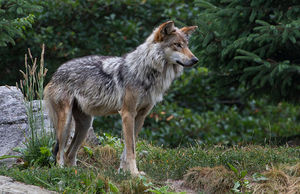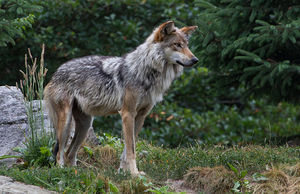
It was 14 years ago, a summer night among the conifers. I’d enjoyed steak for dinner, cooked on a portable barbecue; afterwards, I tucked myself into my sleeping bag inside our Toyota truck.
It was warm out, and I’d left the tailgate down. If I hadn’t, I would have missed the dark gray, deeply ticked fur –– clearly the back of some animal –– standing at the edge of the T100, just six inches from my toes. “That is a tall dog,” I thought. And then: “What’s a husky” (the only breed I could conjure that fit the profile) “doing out here?” With that, the dog raised its head and I glimpsed its actual profile –– which included an unmistakably long nose. It was a wolf.
My own dog had been dozing inside my sleeping bag, also just a few inches from the wolf’s nose. Yet my story’s ending is anything but dramatic. There was no frantic lunge into the back of the truck by the wolf, followed by the shredding of a sleeping bag, the snapping of jaws, the triumphant carting away of a small West Highland terrier, its collar dangling between a predator’s teeth. No, all that happened was this.
I clapped my hands and said, “Go.”
The wolf did not.
I repeated “Go” a little louder, and more urgently.
Slowly, Canis lupus occidentalis ambled away.
I consider myself extremely lucky to have glimpsed a gray wolf on its own turf. We were camped on the edge of the Greater Yellowstone Ecosystem, where, as a result of their reintroduction to Yellowstone National Park and Idaho in 1995, their numbers are thriving. David Parsons has worked on behalf of a subspecies of the gray wolf, Canis lupus baileyi, the so-called lobo, or Mexican gray, for nearly three decades, first as Wolf Recovery Coordinator for the U.S. Fish and Wildlife Service and today as a volunteer with several environmental groups. He’s tracked them via signals from their radio collars, and captured many in pens. But he has witnessed this most elusive of canines in the wild –– briefly, along the rim of a plateau in the heart of the Gila Wilderness, before it disappeared down the other side –– exactly once.
Mexican wolves are critically endangered; the reason Parsons has seen just one of them in nature is because there are only a few dozen at large in the U.S. And all of those have been reintroduced. The reintroduction, which is in accordance with the wolf’s listing through the Endangered Species Act, has been only partially successful. Indeed, this past November, the Endangered Species Coalition awarded the lobo, “the smallest and rarest member of America’s Gray Wolf family,” a dubious honor: It is one of 10 American species on a list of animals in dire need of “safe, navigable corridors” connecting them to crucial habitat or other populations. (The two other predators on the list are the Florida panther and the Yellowstone grizzly bear.)
The Mexican gray originally roamed vast swaths of the southwestern U.S. and Mexico, but their numbers (as is the case with so many wolves) were severely depleted to the point of near extinction by trapping and the U.S. government’s extermination program in the first half of the 20th century. Beginning in 1998, as a result of the captive breeding program, they’ve been restored to a fraction of their former range in the so-called Blue Range Wolf Recovery Area, which stretches between the Gila National Forest in New Mexico and the Apache-Sitgreaves National Forest in Arizona. There were 110 Mexican wolves in 2014; last year, according to a recently-released census by state and federal biologists, their numbers fell to 95. The decrease, according to the Center for Biological Diversity, one of several groups working to save the lobo from extinction, is likely a result of illegal killings, accidents (two animals died after they were captured to replace their radio collars) and something more insidious: their own small numbers. Every lobo that today traverses the Blue Range can trace its lineage to one of just seven individuals. The inbreeding has taken an inexorable toll: Of a total of 40 wolf pups believed to be born last spring, for example, little more than half survived.
That’s where Colorado comes in. Scientists working for the U.S. Fish & Wildlife Service’s wolf recovery group, which is in charge of preventing the wolf from becoming extinct, have said that in order for the lobos to survive, not only must their genetic diversity increase, but their geographic diversity has to as well. The agency’s scientists have recommended reintroducing the wolves to suitable habitat beyond southern Arizona and New Mexico, north of I-40 to the Mogollon Rim of Arizona, the Grand Canyon and Colorado’s southern San Juan mountains.
The question remains whether the lobos will make it north. Despite what the agency’s scientists have recommended –– and opinion polls, which have repeatedly found the public in favor of reintroducing wolves to the wild –– on Nov. 13 of last year, the governors of Utah, New Mexico, Arizona and Colorado sent Secretary of the Interior Sally Jewell and U.S. Fish and Wildlife Director Daniel Ashe a letter stating that “while we support the completion of a [wolf] recovery plan…we do not support the recovery of the Mexican wolf across regions and landscapes that are not part of the subspecies’ historical range.” The letter was followed by another ominous announcement in January, when Colorado Parks & Wildlife approved a resolution (which is an opinion, not a law) opposing the Mexican wolf’s deliberate reintroduction to Colorado. “We’re not opposed to the wolves that come into our state (on their own), we have a history of the gray wolf coming into our state, they have historic range here,” CPW spokesman Matt Robbins said.
Given that the governors from the Four Corners states and the CPW have all cited it as a reason for excluding the lobo, the question is worth asking: How much does the Mexican wolf’s “historic range” really matter to its survival? The answer, according to scientists and environmentalists, is not at all. When the Four Corners states’ governors and CPW say “historic range,” they mean the wolf should be left to live in southern Arizona, New Mexico and Mexico. Yet as the USFWS pointed out in one of its own publications, a 2012 report entitled “North American Fauna,” there is controversy about the historical boundaries of the wolf’s range.
As biologist Steve Forrest, a senior representative for the Rockies & Plains Program of the conservation group Defenders of Wildlife puts it, “A great deal of the lobos’ historic range is lost to history.”
In fact, a group of researchers recently reported in the scientific journal Biological Conservation, evidence suggests the wolf’s historic range “is underestimated.” The investigators reported genetic evidence of a Mexican wolf as far west as California, and suggested it is likely that Mexican wolves and Rocky Mountain gray wolves mixed and interbred in Utah and Nebraska, two of Colorado’s neighboring states. Evidence of Mexican wolves has also been found in Texas and Oklahoma.
“Genetic evidence pretty clearly substantiates that the Mexican wolf did occur in Colorado,” said Delia Malone, of the Rocky Mountain Chapter of the Sierra Club. More to the point, Malone said, “There is nothing in the Endangered Species Act (that) says a creature cannot be recovered in a range outside its historic area. What it does say is that the critter should be restored in an area where it can thrive, and in which there is a proper prey base,” which for wolves means deer and elk.
Adds Michael Robinson, Carnivore Conservation Director of the Center for Biological Diversity and the author of “Predatory Bureaucracy: The Extermination of Wolves and the Transformation of the West,” “The Mexican wolves’ best chance for recovery is beyond their historic range.”
Wolves are what scientists call a keystone species, meaning that they are crucial to other animals’ survival. They have been shown to be beneficial for habitat. Since the wolves’ reintroduction in Yellowstone, for example, their favored prey –– elk — have dispersed from the great herds they once gathered in. As a result, willow stands have flourished. And that has allowed beaver colonies to increase. (There was just one beaver colony in Yellowstone Park when the wolf was first reintroduced. Today, there are nine.) And that’s not all.
